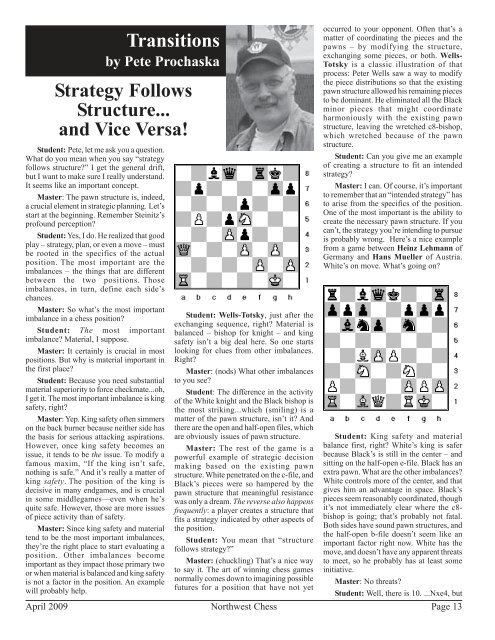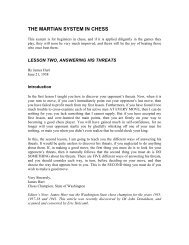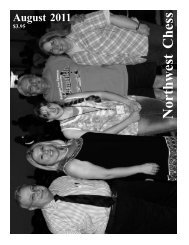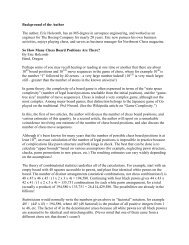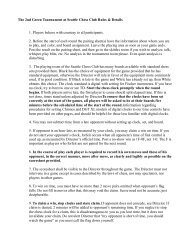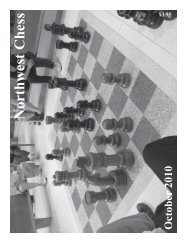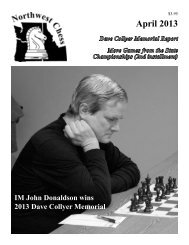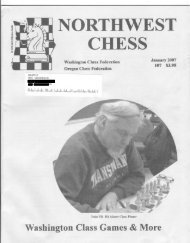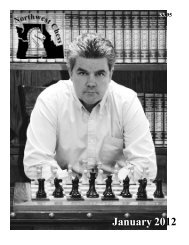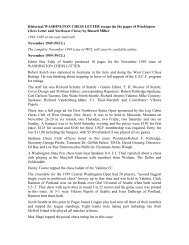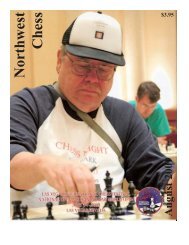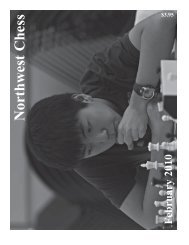April 2009
April 2009
April 2009
Create successful ePaper yourself
Turn your PDF publications into a flip-book with our unique Google optimized e-Paper software.
Transitions<br />
by Pete Prochaska<br />
Strategy Follows<br />
Structure...<br />
and Vice Versa!<br />
Student: Pete, let me ask you a question.<br />
What do you mean when you say “strategy<br />
follows structure” I get the general drift,<br />
but I want to make sure I really understand.<br />
It seems like an important concept.<br />
Master: The pawn structure is, indeed,<br />
a crucial element in strategic planning. Let’s<br />
start at the beginning. Remember Steinitz’s<br />
profound perception<br />
Student: Yes, I do. He realized that good<br />
play – strategy, plan, or even a move – must<br />
be rooted in the specifics of the actual<br />
position. The most important are the<br />
imbalances – the things that are different<br />
between the two positions. Those<br />
imbalances, in turn, define each side’s<br />
chances.<br />
Master: So what’s the most important<br />
imbalance in a chess position<br />
Student: The most important<br />
imbalance Material, I suppose.<br />
Master: It certainly is crucial in most<br />
positions. But why is material important in<br />
the first place<br />
Student: Because you need substantial<br />
material superiority to force checkmate...oh,<br />
I get it. The most important imbalance is king<br />
safety, right<br />
Master: Yep. King safety often simmers<br />
on the back burner because neither side has<br />
the basis for serious attacking aspirations.<br />
However, once king safety becomes an<br />
issue, it tends to be the issue. To modify a<br />
famous maxim, “If the king isn’t safe,<br />
nothing is safe.” And it’s really a matter of<br />
king safety. The position of the king is<br />
decisive in many endgames, and is crucial<br />
in some middlegames—even when he’s<br />
quite safe. However, those are more issues<br />
of piece activity than of safety.<br />
Master: Since king safety and material<br />
tend to be the most important imbalances,<br />
they’re the right place to start evaluating a<br />
position. Other imbalances become<br />
important as they impact those primary two<br />
or when material is balanced and king safety<br />
is not a factor in the position. An example<br />
will probably help.<br />
Student: Wells-Totsky, just after the<br />
exchanging sequence, right Material is<br />
balanced – bishop for knight – and king<br />
safety isn’t a big deal here. So one starts<br />
looking for clues from other imbalances.<br />
Right<br />
Master: (nods) What other imbalances<br />
to you see<br />
Student: The difference in the activity<br />
of the White knight and the Black bishop is<br />
the most striking...which (smiling) is a<br />
matter of the pawn structure, isn’t it And<br />
there are the open and half-open files, which<br />
are obviously issues of pawn structure.<br />
Master: The rest of the game is a<br />
powerful example of strategic decision<br />
making based on the existing pawn<br />
structure. White penetrated on the c-file, and<br />
Black’s pieces were so hampered by the<br />
pawn structure that meaningful resistance<br />
was only a dream. The reverse also happens<br />
frequently: a player creates a structure that<br />
fits a strategy indicated by other aspects of<br />
the position.<br />
Student: You mean that “structure<br />
follows strategy”<br />
Master: (chuckling) That’s a nice way<br />
to say it. The art of winning chess games<br />
normally comes down to imagining possible<br />
futures for a position that have not yet<br />
occurred to your opponent. Often that’s a<br />
matter of coordinating the pieces and the<br />
pawns – by modifying the structure,<br />
exchanging some pieces, or both. Wells-<br />
Totsky is a classic illustration of that<br />
process: Peter Wells saw a way to modify<br />
the piece distributions so that the existing<br />
pawn structure allowed his remaining pieces<br />
to be dominant. He eliminated all the Black<br />
minor pieces that might coordinate<br />
harmoniously with the existing pawn<br />
structure, leaving the wretched c8-bishop,<br />
which wretched because of the pawn<br />
structure.<br />
Student: Can you give me an example<br />
of creating a structure to fit an intended<br />
strategy<br />
Master: I can. Of course, it’s important<br />
to remember that an “intended strategy” has<br />
to arise from the specifics of the position.<br />
One of the most important is the ability to<br />
create the necessary pawn structure. If you<br />
can’t, the strategy you’re intending to pursue<br />
is probably wrong. Here’s a nice example<br />
from a game between Heinz Lehmann of<br />
Germany and Hans Mueller of Austria.<br />
White’s on move. What’s going on<br />
Student: King safety and material<br />
balance first, right White’s king is safer<br />
because Black’s is still in the center – and<br />
sitting on the half-open e-file. Black has an<br />
extra pawn. What are the other imbalances<br />
White controls more of the center, and that<br />
gives him an advantage in space. Black’s<br />
pieces seem reasonably coordinated, though<br />
it’s not immediately clear where the c8-<br />
bishop is going; that’s probably not fatal.<br />
Both sides have sound pawn structures, and<br />
the half-open b-file doesn’t seem like an<br />
important factor right now. White has the<br />
move, and doesn’t have any apparent threats<br />
to meet, so he probably has at least some<br />
initiative.<br />
Master: No threats<br />
Student: Well, there is 10. ...Nxe4, but<br />
<strong>April</strong> <strong>2009</strong> Northwest Chess Page 13


